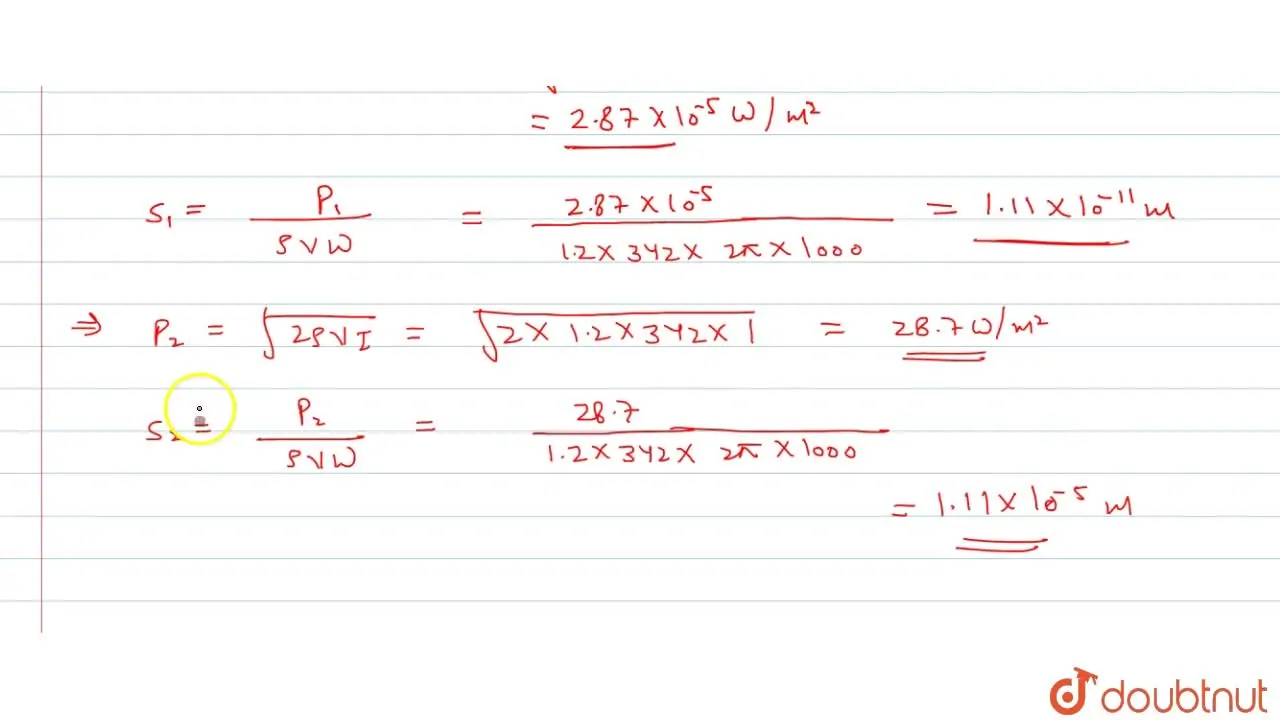The faintest sound the human ear can detect at a frequency of 1000 Hz correspond to an intensity of about 1.00×10−12Wm2, which is called threshold of hearing. The loudest sounds the ear can tolerate at this frequency correspond to an intensity of about 1.00Wm2, the threshold of pain. Detemine the pressure amplitude and displacement amplitude associated with these two limits. Take speed of sound=342ms and density of air=1.20kgm3
Think about the quietest environment you have ever experienced. It is likely that the intensity of sound in even this quietest environment is higher than the threshold of hearing. Because we are given intesities and asked to calculate pressure and displacement amplitudes, this problem requires the concepts discussed in this section.
To find the pressure amplitude at the threshold of hearing,
tr∈∠Pmax=√2ρvI
=√2(1.20kgm3)(342ms)(1.00×10−12Wm2)
=2.87×10−5Wm2
Calculate the corresponding displacement amplitude using
Smax=△Pmaxρvω=2.87×10−5Nm2(1.20kgm3)(342ms)(2π×1000Hz)
=1.11×10−11m
In a similar manner, one finds that the loudest sounds the human ear can tolerate correspond to a pressure amplitude of 28.7Nm2 and a displacement amplitude equal to 1.11×10−5m.
Because atmospheric pressure is about 105Nm2, the result for the pressure amplitude tells us that the ear is sensitive to pressure fluctuations as small as 3 parts in 1010. The displacement amplitude is also a remarkably small number. If we compare this result for Smax to the size of an atom (about 10−10m), we see that the ear is an extremely sensitive detector of sound waves.
Related Playlists
- BOOK - CENGAGE PHYSICSCHAPTER - SOUND WAVES AND DOPPLER EFFECTEXERCISE - Examples56videos
SOUND WAVES AND DOPPLER EFFECT
- BOOK - CENGAGE PHYSICSCHAPTER - SOUND WAVES AND DOPPLER EFFECTEXERCISE - Exercise 6.156videos
SOUND WAVES AND DOPPLER EFFECT
- BOOK - CENGAGE PHYSICSCHAPTER - RIGID BODY DYNAMICS 2EXERCISE - Interger2videos
RIGID BODY DYNAMICS 2
- BOOK - CENGAGE PHYSICSCHAPTER - SUPERPOSITION AND STANDING WAVESEXERCISE - Comprehension Type5videos
SUPERPOSITION AND STANDING WAVES
Similar Questions
A sound wave having a frequency of 100 Hz and pressure amplitude of 10 pa, then calculate the displacement amplitude (Given speed od sound in air = 340 m/s and density of air = 1.29 kgm3)
View SolutionThe faintest sound the human ear can detect at a frequency of kHz (for which ear is most sensitive) corresponds to an intensity of about 10−12w/m2. Assuming the density of air ≅1.5kg/m3 and velocity of sound in air ≅300m/s, the pressure amplitude and displacement amplitude of the sound will be rspectively ____N/m2 and ____m.
View SolutionA 10 W source of sound of frequency 1000 Hz sends out wave in air. The displacement amplitude a distance of 10 m from the source is (speed of sound in air = 340 m/s and density of air = 129 kg/m3)
View SolutionA sound wave in air has a frequency of 300HZ and a displacement ampulitude of 6.0×10−3mm. For this sound waves calculate the (a) Pressure ampulitude (b) intensity (c ) Sound intensity level (in dB)
Speed of sound =344m/s and density of air =1.2kg/m3.View SolutionFor a person with normal hearing, the faintest sound that can be at a frequency of 400Hz has pressure amplitude of about 6.0×10−5 Pa . Calculate the corresponding intensity in W/m2 . Take speed of sound in air as 344m/s and density of air 1.2kg/m3 .
View SolutionA sound wave of frequency 280 Hz has an intensity of 1.00W/m2 ? What is the amplitude of the air oscillations caused by this wave?
View Solution(a) what is the displacemant amplitude for a sound wave having a frequency of 100Hz and a pressure amplitude of 10 pa? (b) The displacement amplitude of a sound wave of frequency 300Hz is 10−7 m. what is the pressure amplitude of this wave ? speed of sound in airb is 340 ml s and density of a ir is 1.29kg/m3.
View SolutionThe maximum pressure variation that the human ear can tolerate in loud sound is about 30N/m2 . The corresponding maximum displacement for a sound wave in air having a frequency of 103Hz is
(Take velocity of sound in air as 300 m/s and density of air 1.5kg/m3)View SolutionPlane harmonic waves of frequency 500 Hz are produced in air with displacement amplitude of 10μm. Given that density of air is 1.29kgm3 and speed of sound in air is 340ms. Then
View SolutionIn expressing sound intensity we take 10−12Wm2 as the reference level. For ordinary conversation the intensity level is about 10−6Wm2. Expressed in decibel, this is
View Solution


